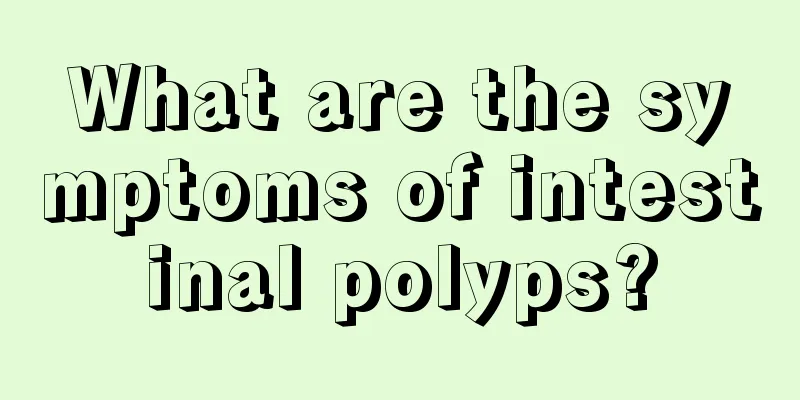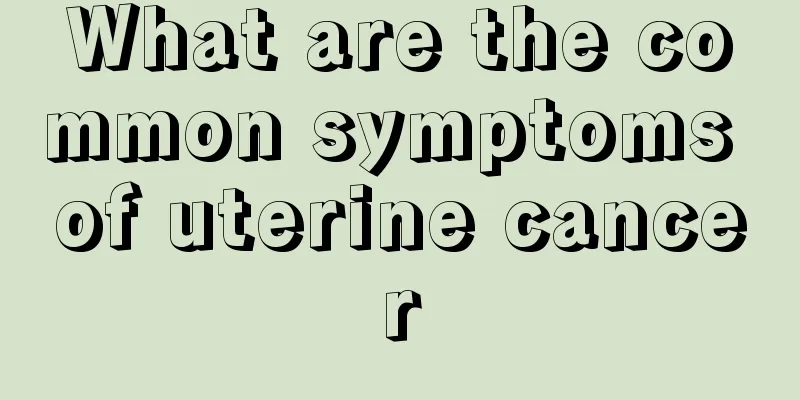What are the symptoms of intestinal polyps?

|
Intestinal polyps are diseases caused by chronic inflammation of the intestinal mucosa. Since the lesions of the intestinal mucosa are prone to the formation of adenomas, it is easy to cause intestinal polyps. The occurrence of intestinal polyps generally manifests as symptoms of blood in the stool, and it is also easy to cause diarrhea, increased frequency of bowel movements, etc., which can cause mild abdominal pain and easily lead to symptoms such as weight loss. It needs to be treated in advance. Intestinal polyp symptoms Most adenomatous polyps of the large intestine have an insidious onset and are free of any clinical symptoms. A few present with changes in bowel habits, blood and mucus in the stool, loose stools, increased frequency of bowel movements, varying degrees of abdominal discomfort, and occasionally systemic symptoms such as abdominal pain, weight loss, and anemia. In very rare cases, tumors may protrude from the anus during defecation. Cases with a family history often provide clues to the diagnosis of polyps. Some typical extraintestinal symptoms often indicate the possibility of polyposis. Some patients often seek medical treatment due to extraintestinal symptoms, which should not be ignored. Since this disease has few clinical symptoms, it is easy to be ignored or missed. Therefore, the diagnosis of colon polyps must first improve the understanding of the disease. Anyone with unexplained blood in the stool or gastrointestinal symptoms, especially middle-aged and elderly men over 40 years old, should pay attention to further examination to increase the detection and diagnosis rate of colorectal polyps. 1. Clinical manifestations. 2. X-ray examination. 3. Endoscopic examination. There are three ways to detect polyps. The most common case is that the polyp is discovered accidentally when the patient comes to the doctor due to intestinal dysfunction (such as irritable bowel syndrome) or rectal bleeding; the second case is that it is discovered during a census of asymptomatic people; the third case is that the polyp is large and the patient comes to the doctor due to bloody stools or the symptoms of the polyp itself. Since most polyps have no clinical symptoms, the detection of polyps through the third route is very limited. prevention Taking anti-inflammatory drugs can help prevent the recurrence of polyps, but you need to pay attention to other side effects of the drugs. At the same time, the effectiveness of this preventive treatment remains to be observed in large numbers of cases. treat The principle of non-surgical treatment of colorectal polyps is to remove the polyps as soon as they are discovered. The choice of treatment depends on their location, the presence or absence of a pedicle, the size and the potential for malignancy. Non-surgical treatment mainly includes endoscopic high-frequency electrocoagulation polypectomy, or laser or microwave resection. Before surgery, the intestine is cleaned and prepared, and resection is performed when the coagulation mechanism is unobstructed. After surgery, the patient is allowed to eat a small amount of fluid or fast for 1 to 3 days, and the amount of activity is restricted. Intravenous hemostatic (such as ethylphenolsulfonamide 3.0 g/d), anti-inflammatory (antibiotics for Gram-positive bacteria), and intestinal mucosal protection (dioctahedral montmorillonite, etc.) treatments are given. The stool color, bowel sounds, etc. are closely observed, and close attention is paid to the occurrence of bleeding and perforation. (1) High-frequency electrocoagulation resection: The following methods can be used according to the shape, size, number, presence, length and thickness of the polyps. ① High-frequency electrocoagulation: mainly used for multiple small hemispherical polyps. ② High-frequency electrocoagulation snare resection: mainly used for pedunculated polyps. ③ "Close contact" removal method: It is mainly used for large polyps with long pedicles. For those that are difficult to suspend in the intestinal cavity, the large polyp close contact intestinal wall electrocoagulation resection method is adopted. ④ High-frequency electrocoagulation thermal biopsy forceps method: rarely used at present. (2) Biopsy forceps method: It is mainly used for single or a few small spherical polyps. It is simple and easy to perform, and biopsy tissue can be obtained for pathological examination. (3) Staged and batch removal: Mainly used for patients with 10 to 20 polyps that cannot be removed at one time. |
<<: Will there be symptoms of urticaria due to vaccination allergy?
>>: What are the symptoms of blocked lung meridian?
Recommend
How to treat cervical calcification, treat according to the cause
There are many reasons for cervical calcification...
Is there any harm if the Pi Xiu is not consecrated?
In ancient China, the Pixiu was a mythical beast ...
What tests are needed if glioma is suspected
Glioma is a brain nerve tumor, which has a certai...
Side effects of acupuncture, precautions to keep in mind
The technology of acupuncture has a history of ma...
Eating spinach can help you stay away from colon cancer
In recent years, with the change of people's ...
Breathing through nose feels dry throat
In life, many people suffer from rhinitis. For so...
Does female uterine cancer have to be removed for treatment? How to take care of uterine cancer after surgery
Uterine cancer is one of the health killers of wo...
How air conditioning works
Air conditioners are a very common household appl...
Nails grow crookedly
Crooked nails are a problem faced by many people....
What are the effects of moxa fumigation on the navel? Do you know these 6 effects?
Mugwort fumigation of the navel is a very popular...
Is pyelonephritis serious?
The causes of many clinical diseases are very com...
Thyroid nodules larger than 1 cm
If people find problems during the physical exami...
What are the surgical methods for lung cancer? Five effective measures to treat lung cancer
With the continuous improvement of living standar...
What kind of tea to make for gynecological inflammation
Many plants can be used to make tea. Common ingre...
What are the nursing methods for teratoma
What are the nursing methods for teratoma? Many p...









